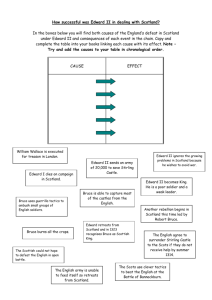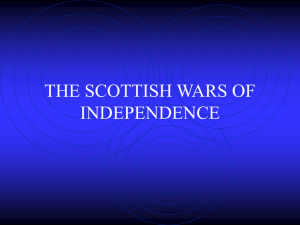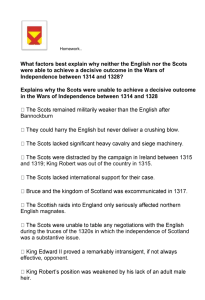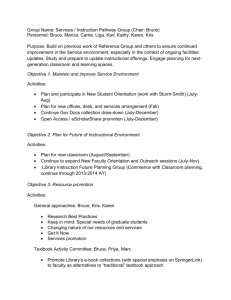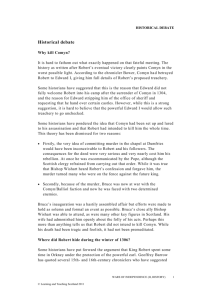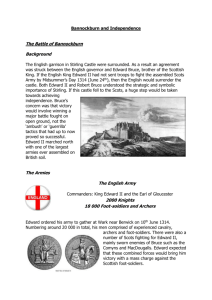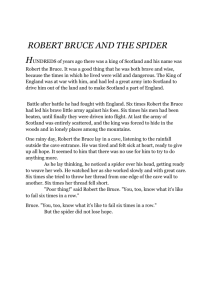The rise and triumph of Robert Bruce: Events
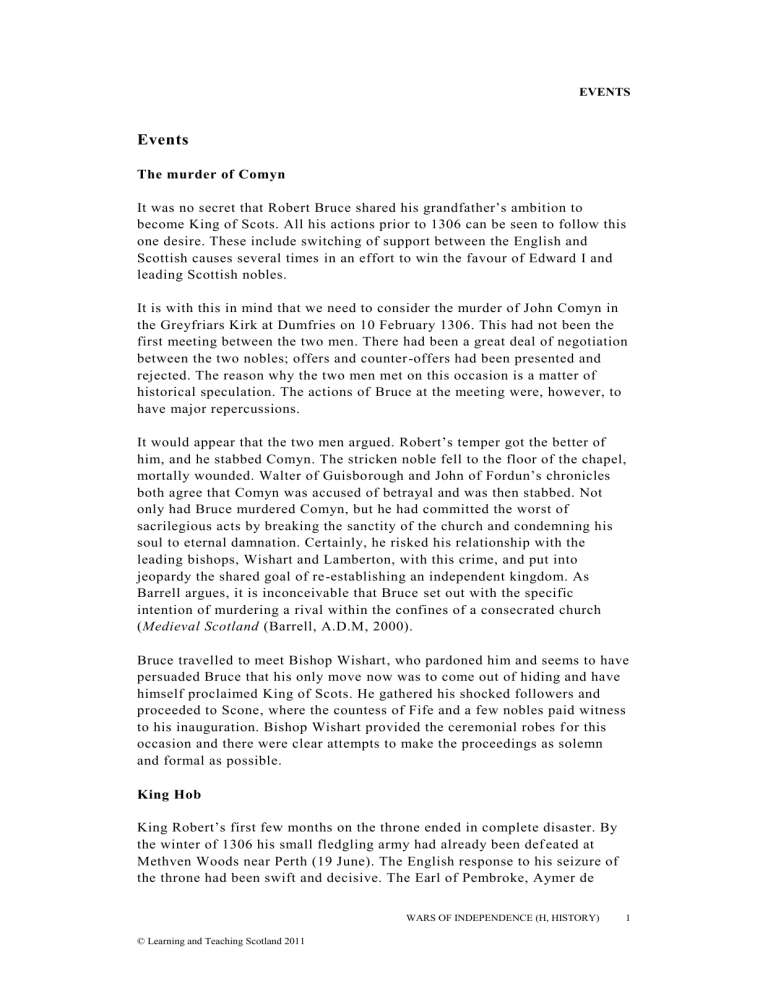
EVENTS
Events
The murder of Comyn
It was no secret that Robert Bruce shared his grandfather’s ambition to become King of Scots. All his actions prior to 1306 can be seen to follow this one desire. These include switching of support between the English and
Scottish causes several times in an effort to win the favour of Edward I and leading Scottish nobles.
It is with this in mind that we need to consider the murder of John Comyn in the Greyfriars Kirk at Dumfries on 10 February 1306. This had not been the first meeting between the two men. There had been a great deal of negotiation between the two nobles; offers and counter -offers had been presented and rejected. The reason why the two men met on this occasion is a matter of historical speculation. The actions of Bruce at the meeting were, however, to have major repercussions.
It would appear that the two men argued. Robert’s temper got the better of him, and he stabbed Comyn. The stricken noble fell to the floor of the chapel, mortally wounded. Walter of Guisborough and John of Fordun’s chronicles both agree that Comyn was accused of betrayal and was then stabbed. Not only had Bruce murdered Comyn, but he had committed the worst of sacrilegious acts by breaking the sanctity of the church and condemning his soul to eternal damnation. Certainly, he risked his relationship with the leading bishops, Wishart and Lamberton, with this crime, and put into jeopardy the shared goal of re-establishing an independent kingdom. As
Barrell argues, it is inconceivable that Bruce set out with the specific intention of murdering a rival within the confines of a consecrated church
( Medieval Scotland (Barrell, A.D.M, 2000).
Bruce travelled to meet Bishop Wishart, who pardoned him and seems to have persuaded Bruce that his only move now was to come out of hiding and have himself proclaimed King of Scots. He gathered his shocked followers and proceeded to Scone, where the countess of Fife and a few nobles paid witness to his inauguration. Bishop Wishart provided the ceremonial robes f or this occasion and there were clear attempts to make the proceedings as solemn and formal as possible.
King Hob
King Robert’s first few months on the throne ended in complete disaster. By the winter of 1306 his small fledgling army had already been def eated at
Methven Woods near Perth (19 June). The English response to his seizure of the throne had been swift and decisive. The Earl of Pembroke, Aymer de
WARS OF INDEPENDENCE (H, HISTORY) 1
© Learning and Teaching Scotland 2011
EVENTS
Valence, had assembled a fast-moving body of horsemen and ambushed King
Robert’s army as it was setting up camp for the night.
As King Robert fled, his murder of Comyn came back to haunt him. One of
Comyn’s relations, MacDougall of Argyll, ambushed what remained of his army at Dalry at the head of Strathfillan. Once again the new King of Scots was forced to flee. Perhaps an even more bitter blow was the news that his family had failed to make it to safety and had been forced to seek refuge at
Kildrummy Castle. However, Edward’s siege of the fortress had been swift and, thanks to treachery from one of the defenders, unnecessary. Robert’s wife and daughter were now in the hands of his enemy, and his younger brother Niall and many of his leading supporters were publicly executed.
Even the venerable Bishop Wishart was captured and taken south to imprisonment in the tower of London.
On the run, with most of his family, allies and friends fallen or captured, the new King of Scots felt anything but a king. It was here that he picked up his nickname, King Hob (King Nobody). King Hob all but f ell out of the history pages for a few months. Some suggest that he headed for Ireland, others that he spent a few months in the Western Isles and Orkney.
Scotland’s civil war
In early 1307, King Robert returned to Scotland and raised a small army that had a few early successes. Bruce’s brothers, Thomas and Alexander, were, however, defeated in Galloway in February 1307. Thomas and Alexander were handed to Edward who had them executed. Bruce himself planned a guerrilla campaign from his base in Carrick. He managed to re -capture
Turnberry Castle in the same month, followed by his defeat of a small
English force at Glen Trool. His first major success in fighting back against the English came on 10 May 1307 at Loudon Hill, when Bruce won a victory against Aymer de Valence, avenged Methven and drew more discontented
Scots to his cause.
Edward decided to lead another invasion into Scotland to deal with Bruce and his uprising, which was gathering support. By this time, however, Edward I was older and more frail. He was carried on a litter and almost reached the border. On 7 July 1307, Edward I died in Cumberland. His tombstone reads,
‘Here lies Edward I, Hammer of the Scots’. The death of Edward I was clearly of great help to Bruce, especially given Edward II’s relative lack of enthusiasm to continue the campaign in the same manner as his father. During the period following 1307, the English were concerned primarily with domestic issues.
2 WARS OF INDEPENDENCE (H, HISTORY)
© Learning and Teaching Scotland 2011
EVENTS
The news of the death of Edward I on 7 July encouraged more men to flock to
Bruce’s banner. The scene was now set for a civil war in Scotland between the Bruce faction and the Comyn family and their supporters.
Bruce decided to take the war to his Scottish enemies. He marched into the heart of Moray and he was able to field a force, according to Bow er, of at least 3000 men. His lightning attacks on the castles of the Comyns and their followers resulted in most of them falling in just a few short months. Bruce captured Inverlochy, Urquhart, Inverness and Nairn castles.
Matters came to a head at the Battle of Inverurie. King Robert had fallen ill and the Earl of Buchan, who had failed to defeat the king earlier at Slioch, saw this as his last chance. His men believed that the king was on his death bed, and were thus encouraged to attack. However, King Robert had recovered enough to lead his men from horseback. Buchan’s forces broke, and with them broke the power of the Comyn family in the north east. King
Robert then ordered the harrowing of the north east, burning crops and livestock alike. This was the Herschip of Buchan, which devastated the area and drove out all who were still loyal to the Comyns. At the same time,
Robert’s last surviving brother, Edward, led an attack an Galloway in June
1308 using similar tactics. By the late summer of 1308, Bruc e was able to launch a successful campaign against Alexander and John MacDougall in
Argyll, achieving victory at the Battle of the Pass of Brander and capturing
Dunstaffnage Castle. Bruce’s position within Scotland was now far more secure. He was able to distribute the lands captured from his enemies to his supporters and was able to hold his first official parliament at St Andrews in
March 1309. The Declaration of the Clergy was written to justify Bruce’s kingship. This declaration can be read as a prelude to the later Declaration of
Arbroath. In the document, the clergy offer their fealty to Bruce and anoint him as the justified ruler of Scotland. Some historians, such as Watson, argue that this is illustrative again of Bruce propaganda, in light of his pe rceived lack of legitimacy as ruler. Furthermore, Bruce received recognition from the
French, a contributing factor to the growing Scottish morale.
With significant progress made against his Scottish enemies, Bruce could now turn his attentions to the English. One by one, each of Edward II’s garrisons fell to Robert or his famous lieutenants, Douglas, Thomas Randolph and Edward Bruce, his brother. Bruce’s supporters captured Perth castle in
January 1309, followed by Dumfries (1313), Isle of Man (1313), Li nlithgow
(1313), Roxburgh (1313) and Edinburgh (1314).
Robert’s policy of destroying all castles that he captured meant that they couldn’t be used against him in the future. In October 1313, King Robert issued an ultimatum to those Scots who supported Ed ward II. He gave them one year to submit to his authority or they would face the permanent loss of
WARS OF INDEPENDENCE (H, HISTORY) 3
© Learning and Teaching Scotland 2011
EVENTS their lands. It is likely that these nobles would have put pressure on Edward to launch another invasion of Scotland. By late 1313 only Berwick and
Stirling remained in English hands. Edward II had not attempted to lead a costly expedition north since 1310, and that invasion had been abandoned.
Stirling, the prized gateway to the north, was willing to surrender if it were not relieved by an English army by midsummer’s day 1314. This was a challenge to his authority that Edward II could not ignore. His army marched north to Bannockburn.
Bannockburn
Bannockburn was the military culmination of Bruce’s campaign. The battle was fought over two days in 1314, 23 a nd 24 June. Edward’s army was significantly larger than that of King Robert. Although not as large as has been proposed by some historians, it was still a significant force and when compared to the Scots, on paper at least, victory appeared certain for the
English king.
First day of the battle
The first day of the battle opened as the English army approached Stirling.
Edward sent two scouting parties forward, both numbering about 300 horsemen. One was under the command of Sir Robert Clifford. This was to scout the flat land to the east of the road, known locally as the Carse. The other, under the command of the Earl of Hereford, rode up the old Roman road towards the Scots position. There Hereford’s men came face to face with
King Robert himself, inspecting his men at the edge of the woods.
On seeing the king, a young knight called Henry de Bohun immediately challenged the king to a duel. He spurred his horse onwards straight to the
Scottish king. Henry de Bohun was considered a great knight, but the King of
Scots simply waited until he was almost upon him then sidestepped his horse and killed the English knight by smashing in the back of his head with a war axe. The Scots pike men then drove off Hereford’s men with ease. Apparently
King Robert’s only comment on the event was to complain about his broken battle axe.
Sir Robert Clifford’s advance fared no better. The Earl of Moray, Thomas
Randolph, led his pike men out of the trees and challenged Clifford’s knights to attack. The knights were also unable to penetrate the thick wall of pikes.
After hearing about the two disastrous scouting missions, Edward and his advisers decided to move the entire army during the night. They decided to take up position across the Carse facing the Scots. They hoped this wou ld catch the Scots unprepared and prevent them escaping. This meant that the
4 WARS OF INDEPENDENCE (H, HISTORY)
© Learning and Teaching Scotland 2011
EVENTS
English spent a restless night, coupled with the blows to morale inflicted by the two defeats.
Second day of the battle
The Scots began the day by marching from the forest and taking up their positions. King Edward was so amazed that the Scots had not run away he exclaimed, ‘My God will they fight?’. When the Scots kneeled in prayer, he even believed they were asking him for his forgiveness.
The English positions had become t erribly confused. The archers were not in a position to fire on the Scots, for fear of hitting their own men. When the three Scots schiltrons advanced towards the English, the knights did what was expected of them and charged. Here, the conditions were far from ideal. The ground was soft underfoot, making it slippery for the horses. The Scots had drilled constantly for this kind of fight. Their closely packed formations of long pikes meant it was impossible for the knights to get near them. The
Scots kept advancing towards the English, slowly pushing them back towards the burn. The knights had no room to manoeuvre or retreat, and were cut down.
When the English archers did manage to position themselves so that they could fire on the Scots without hitting th eir own men, Sir Robert Keith and
James Douglas attacked with their light horses. The English archers were unable to defend themselves and scattered.
Finally, the Scots reserves, made up of the highly disciplined men from
Argyll and the Isles, as well as camp followers, rushed down from the top of
Coxet Hill. Enough was enough and the English broke and ran. Many English knights and commoners met their death while trying to cross the burn as the
Scots gave chase.
King Edward was eventually led away and man aged to escape. Overall it was a most impressive victory, but the war was to continue.
The continuation of the war
While it is true that Bannockburn was a considerable victory for King Robert, it was not a victory that he could use to bring about an end to the war. For another 14 years Robert struggled against Edward II for official recognition as King of Scots. Edward II did share the trait of stubbornness with his father. He was unwilling to surrender the claim to overlordship despite all of
Bruce’s military and diplomatic efforts.
WARS OF INDEPENDENCE (H, HISTORY) 5
© Learning and Teaching Scotland 2011
EVENTS
Following his victory, Bruce issued the Statute of Cambuskenneth in 1314.
This forced the holders of land in both England and Scotland to choose between the two kings and was, therefore, a way of further guara nteeing the loyalty of Bruce’s subjects.
Only a year after Bannockburn, Robert decided to take the battle to Edward
II. He began by opening up a second front in Ireland. His only remaining brother, Edward Bruce, invaded with a sizeable army of Scots. Their intention was to drive the English out of Ireland and crown Edward Bruce King of
Ireland. The plan was then to invade Wales and set up a pan -Celtic alliance to surround England. As ambitious as this plan was, Edward Bruce wasn’t quite the leader his brother was, and he eventually failed in his quest to unite the
Irish clan chiefs and to destroy the English forces. He eventually died in 1318 at Dundalk, having failed to secure the island.
King Robert also took the battle to England. His army invaded the northern counties every year between 1315 and 1318. By the end of 1318, Berwick had been recaptured and the north of England devastated. The Scots were also able to extort much needed protection money from the English communities.
Edward was angered by the Scots recaptur ing Berwick in 1318 so by
September 1319 Edward and the Earl of Lancaster had raised an army and laid siege to Berwick. Bruce sent Thomas Randolph, the Earl of Moray, and
James Douglas into northern England and they caused widespread chaos as far south as Yorkshire, causing Edward to retreat. In autumn 1322 , Edward led an impressive invasion force into Scotland, but Bruce retreated north of the Forth, having removed all livestock from Lothian. Edward retreated and
Bruce chased him and in fact came close to capturing the English king.
The Declaration of Arbroath
While King Edward had little success in defeating King Robert in battle, he did have much more success in isolating Scotland from papal help. After all,
Pope John XXII had excommunicated Robert as p unishment for the murder of
Comyn.
In response, a letter to the Pope was sent from the Scots nobles to plead for the Scottish cause. A copy of this document survives today, and is known as the Declaration of Arbroath.
The letter is a sophisticated argume nt detailing the reasons for Scottish independence and justifying King Robert’s usurpation of the throne in 1306.
The letter, often quoted by historians, shows that to the Scottish people, their desire for freedom is only matched by determination to keep t hat freedom. It even goes so far as to suggest that if the king is not successful in maintaining
6 WARS OF INDEPENDENCE (H, HISTORY)
© Learning and Teaching Scotland 2011
EVENTS the freedom of the kingdom then he may be replaced with someone who will.
This was something almost unheard of in the Middle Ages.
The Treaty of Edinburgh
In 1328 King Robert was finally able to bring England to the peace he had so long desired. Now an old man dying of leprosy, the king lasted long enough to see the treaty sealed.
King Robert had seen his opportunity to step up the pressure on the English throne in 1327 when Edward II was deposed by his wife and her lover,
Mortimer. A coalition of barons seized power and murdered the king. The young prince was hastily crowned Edward III, and his mother and Mortimer were named his legal guardians, essentially in charge of the whole kingdom until he came of age.
King Robert quickly ordered his friend Douglas to invade northern England, while he visited Ireland in the summer of that year. The English at first tried to meet these threats, but were unable to coun ter the swift Scottish attacks.
Fearing yet another rebellion among the barons, Mortimer and Edward’s mother, Isabella, agreed to the Scottish terms for peace.
The Treaty of Edinburgh officially recognised King Robert as King of Scots, and the independence of that kingdom from England. King Robert died in
1329, but had lived long enough to see his final victory.
© Learning and Teaching Scotland 2011
WARS OF INDEPENDENCE (H, HISTORY) 7
